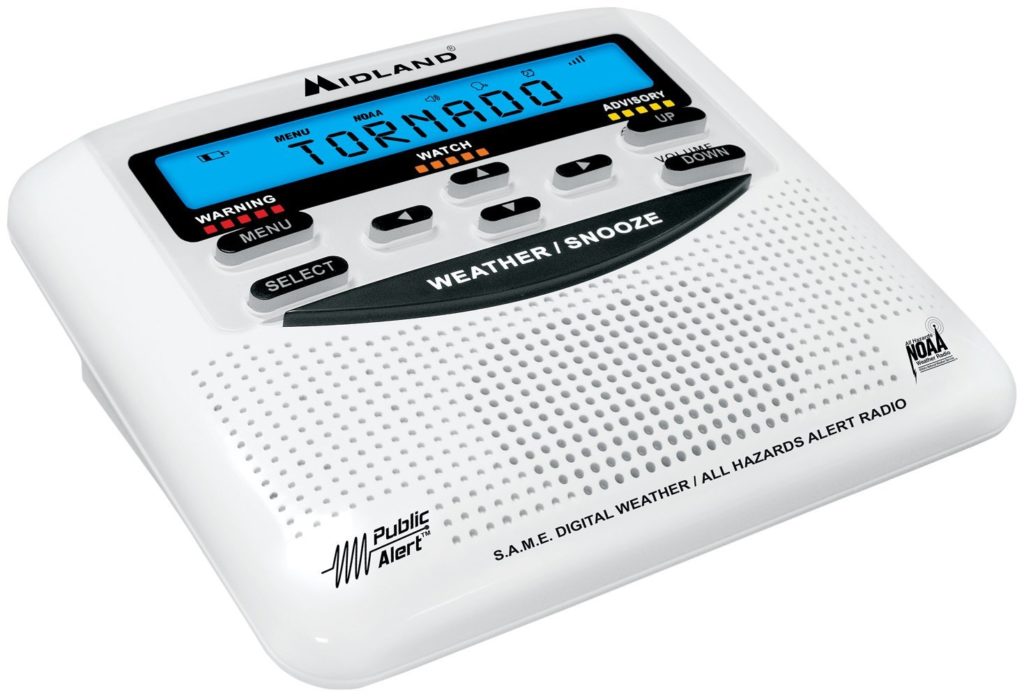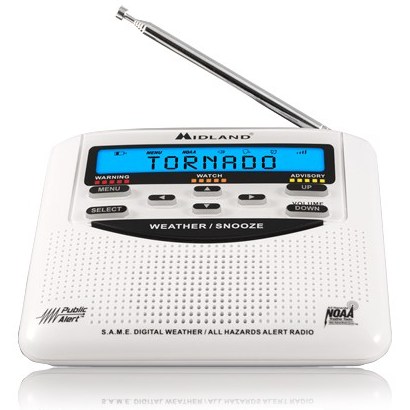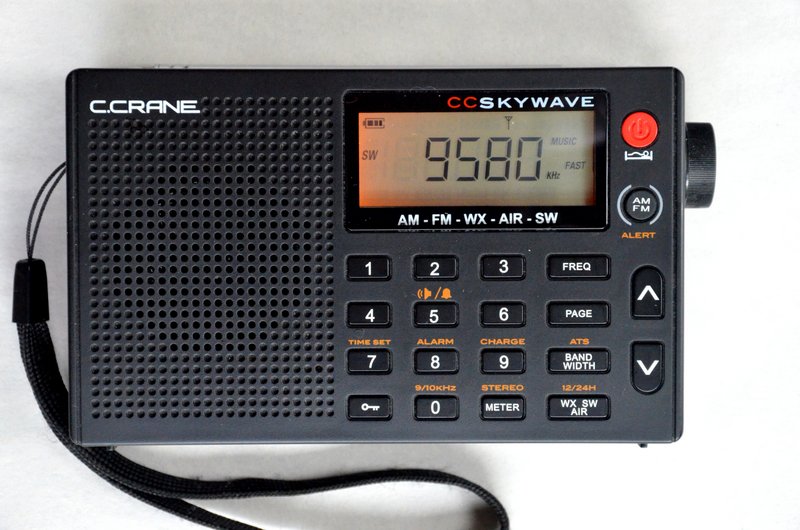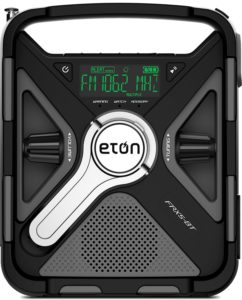Many thanks to SWLing Post reader, Jim T, who writes with the following inquiry:
Wondering if you can give me some guidance re: NOAA weather radios.
We’re looking to be better prepared for disasters, bad weather etc. and have narrowed our radio candidates to CC Crane, Sangean and Kaito.
AM/FM would be nice, hand cranking and solar as well, but just want to get NOAA alerts should we have an earthquake here in the NW. Willing to spend $50-100 for something quality with relevant features to it. Your thoughts would be appreciated!
Thanks for your message, Jim. There are dozens of inexpensive weather radio models on the market, but I know a few good options based on my personal experience.
Note that all of these radios work in both the US (via NOAA) and Canada (via Environment Canada)–both countries have been using the S.A.M.E. (Specific Area Message Encoding) weather alert system since 2004.
The Midland WR120: A dedicated weather radio
If you’re looking for a weather radio to plug in and continuously monitor weather alerts through the S.A.M.E. system, I recommend a dedicated weather radio like theMidland WR120. These radios don’t typically have AM/FM functions, but are entirely devoted to the seven weather radio frequencies in the US and Canada (162.400, 162.425, 162.450, 162.475, 162.500, 162.525, and 162.550 MHz). They plug into mains power and the better ones have battery backup in case of power outages.
I have family that own the Midland WR120. They’ve used it for years and it’s worked flawlessly. Once you set up the radio with your preferred NOAA frequency and SAME alert regions, it will alarm and automatically play NOAA weather radio alerts when they’re issued for your area. My family use this for tornado and storm alerts.
The Midland WR120 uses three AA alkaline cells for emergency power back-up. It’s very much a “set it and forget it” radio and, in my opinion, a bargain at $29.99.
As with any SAME alert radio, be aware that sometimes the alarm can be annoying. Depending on where you live and how the alert system is set up, you might get notifications for isolated weather events on the other side of your county–the S.A.M.E. system cannot pinpoint your neighborhood.
Still, I believe S.A.M.E. notifications are worth any extra inconvenience, especially if you live in an area prone to sudden storms and earthquakes.
Purchase options:
- Midland USA ($49.99)
- Amazon (affiliate link) ($29.99)
- Walmart ($32.88)
- B&H Photo ($29.99)
C. Crane CC Skywave: A portable shortwave radio with excellent NOAA weather reception
If you’re looking for a battery powered radio to use during emergencies that has much more than NOAA weather radio, I’d recommend the C.Crane CC Skywave. Not only is it a full-fledged AM/FM/Shortwave and Air band radio, but it has exceptional NOAA weather radio reception with a weather alert function. The CC Skywave is a great radio to take on travels or keep in the home in case of an emergency. It’ll operate for ages on a set of two AA batteries, though I always keep a pack of four on standby just in case.
You can read a thorough review of the CC Skywave by clicking here. Note that C. Crane is also taking orders for their new CC Skywave SSB which is an upgraded version of the original CC Skywave and includes SSB mode, but costs $80 more than the original.
Purchase options:
- C. Crane $89.99 plus shipping
- Universal Radio $79.95 plus shipping
- Amazon (affiliate link) $89.99
C. Crane CC Solar Observer: A self-powered AM/FM NOAA weather radio
There are a number of self-powered NOAA weather radios out there, but frankly, many are very cheap and the mechanical action of the hand crank are prone to fail early.
I believe one of the best is the CC Solar Observer by C. Crane. It’s durable, and can also run on three AA cells, and is an overall great radio in terms of sensitivity on AM/FM as well. Unique in the world of self-powered radios, it also has a backlit display (which can be turned off or on)–a fantastic feature if the power is out.
Like other self-powered analog radios, the CC Solar Observer has no S.A.M.E. alert functionality.
Purchase options:
- C. Crane $54.99 plus shipping
- Universal Radio $44.95 plus shipping
- REI $49.95 optional shipping
- Amazon (affiliate link) $54.99
One more option: Eton self-powered weather radios
I would also encourage you to check out the wide selection of self-powered weather radios through Eton Corporation.
Many are digital and even have S.A.M.E. weather alerts. I haven’t commented on performance since I haven’t personally tested the 2016 and later models.
Eton typically packs a lot of features in their self-powered radios–having manufactured them for well over a decade, they’ve implemented iterative improvements along the way.
I have tested previous models extensively.
I particularly like the Eton FRX5 although being a digital radio, you get less play time per hand-powered crank–that’s why I prefer analog self-powered radios. The CC Solar Observer, for example, will yield roughly 40 minutes of listening time (at moderate volume levels) on 2-4 minutes of cranking.
Still, if charged fully in advance, I’m sure the FRX5 will play for hours. Note that using S.A.M.E. functionality in standby mode will deplete batteries more quickly.
Click here to view Eton’s full Red Cross radio line on the Eton Corporation website.
Any other recommendations?
Post readers, if I’ve omitted a worthy receiver, please comment with your recommendation.
I hope this helps with your decision, Jim! Thanks for the question!






Not 90 or less, but the Uniden bcd 436hp/536hp is a pretty awesome scanner with a dedicated weather function including same
“Weather radio? I’ll just use my cellphone for alerts.”
If you’ve ever uttered or thought the above words – take heed. Late last week I awoke at around 12:30 AM to the sound of some incredibly strong winds outdoors. Glancing down at my completely muted phone, I opened up my text messages to reveal a Tornado Warning. In a panic, I threw on some clothes, gathered a dog harness and leash and made my way the pantry closest for shelter.
Then I checked my phone again – and realized that tornado warning was from 30 minutes ago and already expired. Crap. That was too close for comfort. I promptly went on to Amazon and ordered the Midland WR120.
I unboxed and set the radio up yesterday and I’m quite happy with it. The first thing I suggest doing after initial setup is turning off the button beeps which are incredibly annoying. Past that, I’ve found the radio perfect for my needs of setting it on a window sill and (hopefully) forgetting about it until it alerts me to any nearby danger.
Since SAME Alerts work on a county basis, I was very happy to discover this radio allows you to disable certain kinds of alerts that may not be relevant to you.
One thing that I think Midland should include in the box printed (instead of ads for weather apps they don’t publish anymore!) is the “Editable Events list:
http://midlandusa.com/wp-content/uploads/2011/11/Editable-Events.pdf
By default, the radio doesn’t allow you to turn off 30 some events, including Tornado Warnings among them – this is a good thing in my opinion! However, it is a bit concerning when you first go to setup the radio and realized Tornado Warning is missing in the alert list. The reason for this is because this is one of the 30 some alerts you can’t disable.
Overall I’m happy with the radio, and hoping it’ll never fire off in the middle of the night on me any time soon – but I know it’ll be a lot more reliable than my cellphone prone to being muted.
I view weather radios like smoke alarms now, it’s stupid for you to not have one. I wasn’t expecting Tornadoes in November in Southeastern Pennsylvania, but apparently nature is one to surprise us continuously.
This Midland brand weather radio is my favorite one. I have been using this for last 2 years. The device has public authorized monitor comprehensively covers 7 channels aired on the NOAA. The device has a memory power that locks down the weather information of twenty-five countries at a time. The SAME feature can be very handy as it gives alerts based on zones(County).
I’ve been pretty happy with the Reecom R-1650. ( from http://www.reecominc.com/ ) I’ve had it over 10 years and it’s been a solid performer. It has a long battery backup on 4 AA’s. It also does AM/FM, has alarm out, antenna in, audio out etc. It’s fairly smart and doesn’t alert me when the Wednesday tests are happening but does light up during the test so it’s easy to see that it’s working and receiving alerts as it should. Getting through the programming menu is a little weird (as it is with most weather radios) but I can usually figure it out with having to hunt down the manual even though I haven’t been in the menu in years.
With the advent of the cell phone, where no one thinks they need a radio anymore for anything, the best deal in weather radios is often found at Goodwill or your local thrift shop. You can often find models with S.A.M.E for $2-3.
“With the advent of the cell phone, where no one thinks they need a radio anymore for anything, the best deal in weather radios is often found at Goodwill or your local thrift shop. You can often find models with S.A.M.E for $2-3.”
This type of thing is amazing to me. A couple of months back, during a weather event, several people on my sub division’s Facebook page were very upset that cable television was out. They were asking things like how are we supposed to know if the conditions are getting better or continuing to degrade? How do we know if school is cancelled or postponed?
I added a comment on the post mentioning that they could pull out an AM radio and tune to a local AM station. People were perplexed. There were a number of responses that ranged from “great idea, Thank you!” to “where would I find an AM radio”
Some of this is generational I would guess but some of it is just a change in how we as a society consumes media.
Radio’s are very useful tools. Everyone should really keep at least one around.
Most of the newer clock radios even from name-brands, such as iHome, are FM only so it’s no wonder they’re “perplexed”. It’s times like this that it’s probably a good idea to share a link to a Red Cross or FEMA emergency preparedness page.
I use my scanner for the weather channels. I simple Uniden BC75XLT or BC125AT (can often be found under $100) work well. These also might allow you to monitor other frequencies.
I have the Sangean CL-100 and highly recommend the radio for several reasons and in fact I bought several for family members as gifts. The Sangean CL-100 looks like an alarm clock and is what I use as an alarm clock but the CL-100 is a full featured weather radio as well. The audio quality for general broadcast is excellent for a radio this size and the build quality is very good. I bought mine several years ago and have not had any issues. (About $60.00 from Amazon)
Some of the features I like and why.
S.A.M,E (Specific Area Message Encoding) Alerts only for your county. If a thunderstorm passes through a county next to you at 4:00 AM you will not be woken up. This has happened to me several times with my previous non S.A.M.E radio and I just ended up turning the radio completely off which obviously left me vulnerable to the next event.
Selectable Alerts – disable alerts that you may not care about such as wind advisory. Again I have been woken up with my previous weather radio that didn’t have this feature for a wind advisory early in the morning. Very irritating.
End-of-message (EOM) Radio turns off after alert is given so you don’t have to get out of bed just to turn the alert off.
RBDS (Radio Broadcast Data System) You can set the radios clock as well as the radio will display station ID and song name.
Display is excellent and has a wide viewing angle plus you can adjust the brightness. I do wish the display was a little bigger and mounted on the front of the radio VS the top so it would be easier to see the time if you wake up during the night.
Two separate alarms and can be programed for different days of the week.
Human Wake-up System – Alarm starts at a very low level and gradually builds up in volume. You can set the alarm to buzzer or radio broadcast. I hate being jolted out of bed by a nasty sounding alarm.
The jacks include DC power in, stereo earphone, AM external antenna, FM/weather external antenna, aux-in, external alert and grounding terminal.